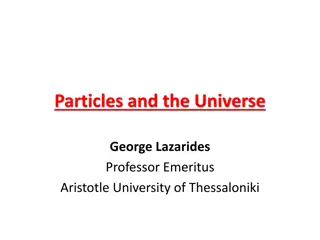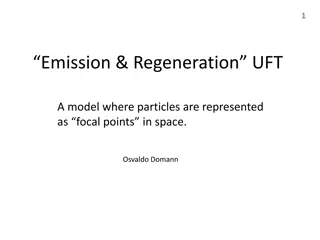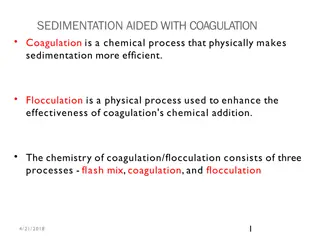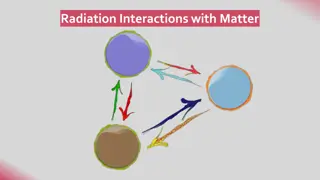LECTURE 1: Air We Breathe Course Overview
Americans predominantly spend 90% of their time indoors, where each breath taken contains particles sourced from various levels - global, regional, local, and indoor sources. These particles, known as particulate matter (PM), can have differing effects on the body based on their size, with smaller p
2 views • 18 slides
Understanding Radioactive Decay and Nuclear Radiation
Radioactive decay is the process in which unstable atomic nuclei emit charged particles and energy, transforming into different elements. This process involves the emission of alpha particles, beta particles, and gamma rays. Alpha particles consist of two protons and two neutrons, beta particles are
4 views • 31 slides
Exploring Particles and Fundamental Interactions in the Universe
Delve into the intricate world of particles and fundamental interactions in the Universe as explained by Professor Emeritus George Lazarides from Aristotle University of Thessaloniki. Discover the structure of matter, classification of particles based on interactions, constituents of hadrons, conser
1 views • 36 slides
Exploring Dark Sector Particles at Fermilab PIP-II and Beyond
The DAMSA experiment at Fermilab PIP-II aims to search for Dark Sector Particles (DSP) using a high-intensity proton beam facility. By focusing on Axion-like particles and employing specific physics strategies, DAMSA seeks to penetrate the low mass regime and discover rare particles in unexplored ki
6 views • 22 slides
Understanding Total Solids and Total Suspended Solids in Water
Learn about total solids and total suspended solids in water, including their definitions, implications on water quality and aquatic life, and factors affecting their levels. Total solids refer to matter suspended or dissolved in water, while total suspended solids are small solid particles that can
7 views • 12 slides
Understanding the States of Matter: Solids, Liquids, and Gases
Matter is anything that occupies space and has mass, consisting of tiny particles like atoms and molecules. Solids have closely packed particles, liquids have less densely packed particles that can flow, and gases have spread out particles. Solids retain their shape, liquids take the shape of their
6 views • 11 slides
Constitutional Court judgments with suspended orders.
The Constitutional Court in South Africa has issued judgments with suspended orders in various cases relating to Acts that were deemed inconsistent with the Constitution. Orders in cases like the Riotous Assemblies Act and Drugs and Drug Trafficking Act are set to lapse on specific dates unless the
4 views • 44 slides
Heisenberg's Uncertainty Principle in Elementary Quantum Mechanics
Heisenberg's Uncertainty Principle, proposed by German scientist Werner Heisenberg in 1927, states the impossibility of simultaneously and accurately determining the position and momentum of microscopic particles like electrons. This principle challenges classical concepts of definite position and m
0 views • 49 slides
Chemistry Regents June 2022 - Subatomic Particles and Atomic Experiments
Understanding subatomic particles, atomic experiments, and spectroscopy concepts in chemistry for the June 2022 Regents exam. Learn about particle charges, gold foil experiment conclusions, and bright-line spectrum elements.
0 views • 167 slides
Understanding Radioactivity and its Particles in Radiochemistry
Radioactivity involves the spontaneous decay of unstable atomic nuclei, releasing radiation in the form of alpha particles, beta particles, and gamma rays. Alpha particles are heavy and have low penetration, beta particles are light and faster, while gamma rays are high-energy waves with great penet
0 views • 20 slides
Progress Report on Suspended Constitutional Court Orders - Portfolio Committee Update
Progress report on suspended Constitutional Court orders related to various cases such as Minister of Justice and Constitutional Development v. Prince, Sonke Gender Justice NPC v. President of South Africa, and more. Updates on bills, amendments, and plans presented by the Portfolio Committee on Jus
0 views • 9 slides
Realistic Particle Representations and Interactions in Emission & Regeneration UFT
The presentation explores a model in which particles are depicted as focal points in space, proposed by Osvaldo Domann. It delves into theoretical particle representations, motivation for a new approach, and the methodology behind the Postulated model. Additionally, it delves into particle represent
1 views • 24 slides
Understanding Precipitation in Pharmacy and Chemistry
Precipitation is a crucial process in chemistry and pharmacy, where solid particles are separated from a clear liquid solution. This method is used for various purposes like obtaining fine particles, purifying powders, and preparing pharmaceutical substances. Examples include calcium carbonate, ammo
7 views • 10 slides
Understanding Dynamics: Rectilinear Kinematics in Continuous Motion
Dive into the study of dynamics by exploring the kinematics of particles moving along straight paths. Learn about position, displacement, velocity, and acceleration along with key concepts and formulas. Understand the significance of considering objects as particles and focus on the motion character
0 views • 10 slides
Understanding Mole Calculations in Chemistry
Explore various mole calculations in chemistry such as determining mass from moles, moles from mass, and comparing particles in different substances. Learn how to calculate the mass of substances, the number of particles, and perform calculations using balanced equations. Dive into concepts like mol
0 views • 49 slides
Understanding Atomic Structure and Subatomic Particles
Delve into the world of atomic structure and subatomic particles to reveal the inner workings of elements. Discover how to determine atomic mass, identify protons, neutrons, and electrons, and interpret the periodic table. Explore the key concepts of isotopes, electron configurations, and the charac
0 views • 6 slides
Exploring the Nature of Subatomic Particles and Light
Explore the intricate world of subatomic particles such as electrons, protons, and neutrons, and delve into the dual nature of light as both particles and waves. Discover the structure of atoms, their isotopes, atomic number, mass number, and the fundamental discoveries in the field of physics, incl
1 views • 16 slides
Quantum Mechanics of Hydrogen Molecule Rotations
Dive into the intriguing world of molecular rotations in hydrogen molecules, exploring topics such as rotational heat capacity, moment of inertia, nuclear spin isomers, and wave number calculations. Understand the implications of particle interactions, distinguishable vs. indistinguishable particles
0 views • 23 slides
Exploring Parts of the Atom: A Visual Journey
Delve into the discovery of the constituents of an atom, from the negatively charged particles in the electron cloud to the positively charged particles in the nucleus. Learn about protons, neutrons, and the particle with no charge as they form the building blocks of matter. Engage with visually sti
4 views • 17 slides
Understanding Sedimentation Aided with Coagulation and Flocculation
Sedimentation aided with coagulation and flocculation is a chemical and physical process used in water treatment to efficiently remove impurities and particles. Coagulation involves adding chemicals to neutralize particles, while flocculation helps in forming larger clumps for easier removal. The en
1 views • 54 slides
Understanding the Mole and Avogadro's Law at Standard Temperature and Pressure (STP)
The lesson delves into the concepts of mole and Avogadro's law in relation to gases at standard temperature and pressure (STP). It explains how chemists track the number of gas particles using the mole unit, and highlights the significance of STP in gas calculations. Equal volumes of gases contain e
0 views • 9 slides
Understanding Radioactivity and Nuclear Radiation
Radioactivity is the process in which unstable nuclei emit radiation, such as alpha, beta, or gamma particles, to become stable. This emission can change the element's identity and is crucial in fields like nuclear power and understanding Earth's core heat source. Different radioactive isotopes like
0 views • 12 slides
Understanding Sedimentation: Types and Applications
Sedimentation is a physical treatment process that separates suspended solids from water using gravity. There are four types of sedimentation: discrete settling, flocculant settling, hindered settling, and compression settling. Each type describes different behaviors of solid particles as they settl
3 views • 25 slides
Unified Field Theory of Fundamental Particles by Osvaldo Domann
Methodology, characteristics, and interactions of Fundamental Particles (FPs) in the Unified Field Theory proposed by Osvaldo Domann are explored. The theory covers the unified field for all forces, quantum laws, momentum quantification, and more. It introduces the concept of Fundamental Particles m
0 views • 21 slides
Exploring the Dual Nature of Particles and Waves in Physics
This collection of images and information delves into the intriguing concept of the dual nature of particles and waves in the field of physics. From the historic Young's double-slit experiment demonstrating the wave nature of light to Louis de Broglie's groundbreaking work assigning a wavelength to
3 views • 15 slides
Understanding Filtration: Process, Applications, and Mechanisms
Filtration is a process of separating solid particles or suspended matter from liquid or gas by passing it through a porous medium. This article discusses the definition of filtration, factors affecting its rate, applications in various industries, mechanisms involved, and different types of filtrat
1 views • 6 slides
Understanding Particulate Matter (PM) and Its Health Effects
Particulate Matter (PM) refers to tiny particles suspended in the air that can have significant health effects, especially PM2.5 which can penetrate deep into the lungs. This overview covers the composition, sources, health effects, particle sizes, lung penetration, regulatory standards, and ambient
0 views • 34 slides
Light Optical Aerosol Counter (LOAC) Project Overview
Light Optical Aerosol Counter (LOAC) is a project led by Jean-Baptiste Renard in France, involving a collaboration between research institutions, private companies, and the French Space Agency. The LOAC instrument, weighing 1 kg, is used with meteorological balloons to measure concentrations of aero
0 views • 21 slides
Understanding Sediment Transport in Fluvial Hydraulics
Sediment transport equations play a crucial role in predicting sediment capacity under different flow conditions, aiding in various analyses like aggradation, degradation, scour, deposition, and migration. Different formulas cater to varied scenarios, distinguishing between bed load and suspended lo
0 views • 82 slides
NHL Department of Player Safety: Suspension Analytics and Player Offender Data
Explore the NHL's Department of Player Safety analytics on player suspensions since 2011-2012. Discover the most suspended and least suspended teams, reasons for suspensions, injury data, repeat offender definitions, and more.
0 views • 14 slides
Understanding Ionizing Radiation and Its Interactions with Matter
Ionizing radiation interacts with matter in direct and indirect ways, leading to various effects on biological systems. Directly ionizing particles disrupt atomic structures, while indirectly ionizing radiation like electromagnetic waves produce secondary electrons. Alpha particles have high ionizat
0 views • 22 slides
Understanding Dynamics of Connected Particles in Physics
Delve into the world of connected particles in physics with a focus on tow bars, forces, and Newton's laws. Explore problems involving connected particles moving in the same direction and analyze scenarios like towing cars along a road. Gain insights into tension, accelerations, resistances, and for
0 views • 14 slides
Understanding Radiation and Its Effects on Health
Radiation is a form of energy that can be emitted from radioactive materials in the form of particles or waves. It can be either ionizing or non-ionizing, with ionizing radiation having the ability to penetrate tissues and deposit energy within them. While alpha particles, beta particles, x-rays, an
1 views • 38 slides
Understanding Magnetism: Forces, Fields, and Applications
Explore the fascinating realm of magnetism in Physics as you delve into topics such as forces on charged particles, path of particles in magnetic fields, torque on current loops, and Earth's magnetic field alignment. Learn about the force on straight wires and electric charges in magnetic fields, an
0 views • 14 slides
Understanding the Impact of Ultra-High Energy Particles on Biological Systems
Ultra-high energy particles from outer space create Extended Air Showers (EAS) when interacting with Earth's atmosphere, leading to the formation of dense cores emitting radiation. These particles can affect biological organisms, memory storage, and health risks, with implications for medical resear
0 views • 5 slides
Exploring Elementary Particles and Their Interactions in Nuclear and Particle Physics
Delve into the fascinating world of elementary particles, where quarks form the basis of protons and neutrons in the nucleus, alongside electrons. Discover a diverse array of particles such as muons, neutrinos, and quarks, each with unique properties of charge and mass. Uncover the significance of t
0 views • 10 slides
Understanding Moles in Chemistry
Matter is composed of various particles, and chemists use the concept of moles as a unit of measure to quantify the number of particles in a substance. One mole is equal to 6.02 x 10^23 representative particles of a substance, known as Avogadro's number. Moles are versatile and applicable to differe
0 views • 25 slides
Understanding Kappa Particles Transmission in Paramecium
Research by Dr. Shashikant R. Sitre delves into the transmission of kappa particles in Paramecium, revealing the presence of these cytoplasmic particles in specific strains. The interaction between killer and sensitive strains, controlled by the dominant K gene, sheds light on cytoplasmic heredity a
0 views • 10 slides
Relativistic Treatment of Spin Particles: Dirac Equation & Special Relativity
Exploring the Dirac equation for spin particles within the framework of special theory of relativity. Topics covered include energy-momentum relationships, basics of special relativity, Lorentz transformations, and relativistic effects on particles. The lecture delves into the interplay between quan
0 views • 23 slides
Calculating Weight of Gymnast Suspended by Ropes
The figure shows a gymnast suspended by his arms at the end of two ropes with tensions of 4.1 x 10^2 N each at an angle of 65 degrees. By applying principles of gravitational fields and Newton's law of gravitation, we can calculate the weight of the gymnast. The gravitational constant is utilized to
0 views • 18 slides







































